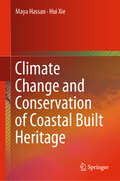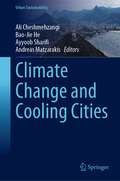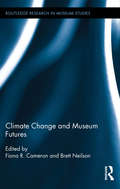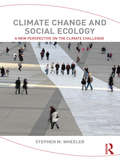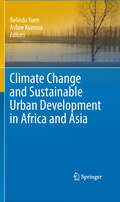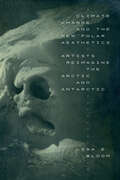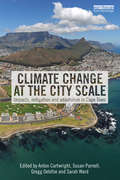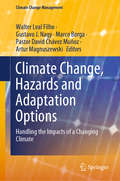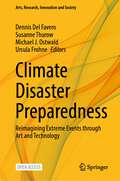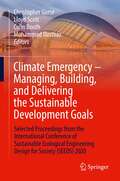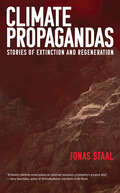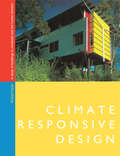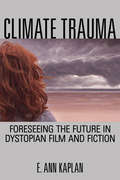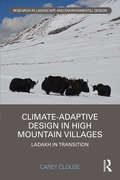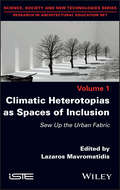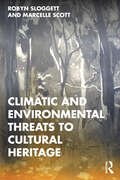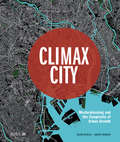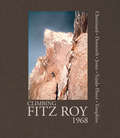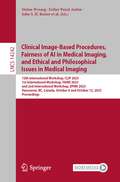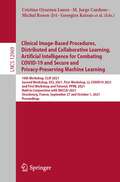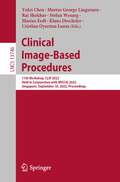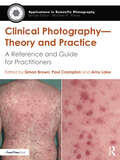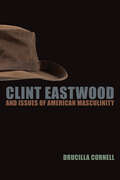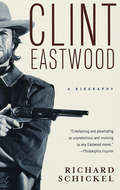- Table View
- List View
Climate Change and Conservation of Coastal Built Heritage
by Maya Hassan Hui XieThis book presents the preservation principles and the current environmental challenges relating to monitoring heritage sites and buildings under the effects of climate change. It provides a clear overview of conservation action levels and the importance of participation and cooperation between them, and discusses evaluation and management methods, thermal comfort for the common usages, and conceptual methods for enhancing the built heritage. The research presented employed the “Zoom In, Zoom Out” approach for monitoring the Syrian coastal heritage sites threatened by the direct and indirect effects of climate change. Lastly, the book establishes the basic principles and conservation strategies for preserving the coastal heritage sites and buildings. As such, it is a valuable reference resource for researchers, developers, architects, and conservators involved in protecting the architectural heritage in coastal areas. It can also be used as a guidebook on preserving and monitoring built heritage sites at both macro and micro levels.
Climate Change and Cooling Cities (Urban Sustainability)
by Ali Cheshmehzangi Ayyoob Sharifi Bao-Jie He Andreas MatzarakisThis edited book provides a solid foundation for future research on cooling cities, climate change impacts on cities and urban environments, and innovative mitigation and adaptation strategies. With ever-increasing climate change impacts on our living environments and continuous calamities and natural disasters around the world, we urge for new approaches, apt action, and adequate support to boost cooling strategies for the built environments. To achieve this goal, research, practice, and policy could do much more to provide us with new pathways to achieve sustainable development. This book is a comprehensive collection of theoretical perspectives and global case study examples focused on three core areas of (1) concepts, theories, and trends, (2) mitigation and adaptation strategies, and (3) policies. The book is of use to various stakeholders and more importantly to urban specialists, planners and designers, policymakers, academics, practitioners, and developers. We urge them to mitigate climate change before it gets too late. We are confident the book could provide readers with new ideas, strategies, and directions that could lighten up the path toward new actions, policies, and innovation.
Climate Change and Museum Futures (Routledge Research in Museum Studies)
by Fiona Cameron Brett NeilsonClimate change is a complex and dynamic environmental, cultural and political phenomenon that is reshaping our relationship to nature. Climate change is a global force, with global impacts. Viable solutions on what to do must involve dialogues and decision-making with many agencies, stakeholder groups and communities crossing all sectors and scales. Current policy approaches are inadequate and finding a consensus on how to reduce levels of greenhouse gases in the atmosphere through international protocols has proven difficult. Gaps between science and society limit government and industry capacity to engage with communities to broker innovative solutions to climate change. Drawing on leading-edge research and creative programming initiatives, this collection details the important roles and agencies that cultural institutions (in particular, natural history and science museums and science centres) can play within these gaps as resources, catalysts and change agents in climate change debates and decision-making processes; as unique public and trans-national spaces where diverse stakeholders, government and communities can meet; where knowledge can be mediated, competing discourses and agendas tabled and debated; and where both individual and collective action might be activated.
Climate Change and Social Ecology: A New Perspective on the Climate Challenge
by Stephen M. WheelerAlthough strategies to prevent global warming – such as by conserving energy, relying on solar and wind power, and reducing motor vehicle use – are well-known, societies have proved unable to implement these measures with the necessary speed. They have also been unwilling to confront underlying issues such as overconsumption, overpopulation, inequity, and dysfunctional political systems. Political and social obstacles have prevented the adoption of improved technologies, which would provide only a partial solution in any case if the fundamental causes of greenhouse gas emissions aren’t addressed. Climate Change and Social Ecology takes a new approach to the climate crisis, portraying global warming as a challenge of rapid social evolution. This book argues that, in order to address this impending catastrophe and bring about more sustainable development, we must focus on improving social ecology – our values, mind-sets, and social organization. Steps to do this include institutional reforms to improve democracy, educational strategies to encourage public understanding of complex issues, and measures to prevent corporations and the wealthy from shaping societies in other directions instead. This book presents a captivating vision of how to help social systems evolve toward sustainability and explores the social transformations needed for dealing with the climate crisis in the long term. It reviews the climate change strategies considered to date, presents a detailed description of a future sustainable society, and analyzes how this vision might be realized through more conscious public nurturing of our social systems. This interdisciplinary volume provides a compelling rethink of the climate crisis. Authoritative and accessible, it will be of great interest to anyone concerned about climate change and sustainability challenges and is essential reading for students, professionals, and general readers alike.
Climate Change and Sustainable Urban Development in Africa and Asia
by Belinda Yuen Asfaw KumssaThis book is about African and Asian cities. Illustrated through selected case cities, the book brings together a rich collection of papers by leading scholars and practitioners in Africa and Asia to offer empirical analysis and up-to-date discussions and assessments of the urban challenges and solutions for their cities. A number of key topics concerning housing, sustainable urban development and climate change in Africa and Asia are explored along with how policy interventions and partnerships deliver specific forms of urban development. It is intended for all who are interested in the state of the cities and urban development in Africa and Asia. Africa and Asia present, in many ways, useful lessons in dealing with the burgeoning urban population, and the problems surrounding this influx of people and climate change in the developing word.
Climate Change and the New Polar Aesthetics: Artists Reimagine the Arctic and Antarctic
by Lisa E. BloomIn Climate Change and the New Polar Aesthetics, Lisa E. Bloom considers the ways artists, filmmakers, and activists engaged with the Arctic and Antarctic to represent our current environmental crises and reconstruct public understandings of them. Bloom engages feminist, Black, Indigenous, and non-Western perspectives to address the exigencies of the experience of the Anthropocene and its attendant ecosystem failures, rising sea levels, and climate-led migrations. As opposed to mainstream media depictions of climate change that feature apocalyptic spectacles of distant melting ice and desperate polar bears, artists such as Katja Aglert, Subhankar Banerjee, Joyce Campbell, Judit Hersko, Roni Horn, Isaac Julien, Zacharias Kunuk, Connie Samaras, and activist art collectives take a more complex poetic and political approach. In their films and visual and conceptual art, these artists link climate change to its social roots in colonialism and capitalism while challenging the suppression of information about environmental destruction and critiquing Western art institutions for their complicity. Bloom’s examination and contextualization of new polar aesthetics makes environmental degradation more legible while demonstrating that our own political agency is central to imagining and constructing a better world.
Climate Change at the City Scale: Impacts, Mitigation and Adaptation in Cape Town
by Sarah Ward Susan Parnell Anton Cartwright Gregg OelofseClimate change impacts are scale and context specific, and cities are likely to bear some of the greatest costs. In recent years cities have begun to craft their own climate change responses against the backdrop of the reluctance displayed by nation-states in committing to emissions reductions and managing the consequences of climate change. Climate Change at the City Scale presents a fresh contribution to climate change literature, which has largely neglected the role of cities in spite of their increasingly important role in the global economy. The book focuses on the impacts of climate change in the rapidly evolving city of Cape Town, and captures the experiences of the Cape Town Climate Change Think Tank, a hybrid knowledge partnership which has produced research on a range of urban governance, impacts, mitigation and adaptation challenges by the City. Cape Town has long been acknowledged as an innovator in the area of urban environmental management, notwithstanding its limited resources to manage the demand for a more resilient and equitable future. By documenting the work and experiences of the City’s efforts to define its own climate future, the book provides a provocative case study of the way in which the science-policy interface can be managed to inform urban transformation.
Climate Change, Hazards and Adaptation Options: Handling the Impacts of a Changing Climate (Climate Change Management)
by Walter Leal Filho Gustavo J. Nagy Marco Borga Pastor David Chávez Muñoz Artur MagnuszewskiThis book addresses the issue of climate change risks and hazards holistically. Climate change adaptation aims at managing climate risks and hazards to an acceptable level, taking advantage of any positive opportunities that may arise. At the same time, developing suitable responses to hazards for communities and users of climate services is important in ensuring the success of adaptation measures. But despite this, knowledge about adaptation options, including possible actions that can be implemented to improve adaptation and reduce the impacts of climate change hazards, is still limited. Addressing this need, the book presents studies and research findings and offers a catalogue of potential adaptation options that can be explored. It also includes case studies providing illustrative and inspiring examples of how we can adapt to a changing climate.
Climate Disaster Preparedness: Reimagining Extreme Events through Art and Technology (Arts, Research, Innovation and Society)
by Michael J. Ostwald Ursula Frohne Dennis Del Favero Susanne ThurowAs a result of global warming, extreme events, such as firestorms and flash floods, pose increasingly unpredictable and uncertain existential threats, taking lives, destroying communities, and wreaking havoc on habitats. Current aesthetic, technological and scientific frameworks struggle to imagine, visualise and rehearse human interactions with these events, hampering the development of proactive foresight, readiness and response.This open access book demonstrates how the latest advances in creative arts, intelligent systems and climate science can be integrated and leveraged to transform the visualisation of extreme event scenarios. It reframes current practice from passive perception of pre-scripted illustrations to active immersion in evolving life-like interactive scenarios that are geo-located. Drawing on the multidisciplinary expertise of leaders in the creative arts, climate sciences, environmental engineering, and intelligent systems, this book examines the waysin which climate disaster preparedness can be reformulated through practices that address dynamic and unforeseen interactions between climate and human life worlds. Grouped into four sections (picturing, narrating, rehearsing, and communicating), this book maps this approach by exploring the emerging strengths and current limitations of each discipline in addressing the challenge of envisioning the unpredictable interaction of extreme events with human populations and environments. This book provides a timely intervention into the global discourse on how art, culture and technology can address climate disaster resilience. It appeals to readers from multiple fields, offering academic, industry and community audiences novel insights into a profound gap in the current knowledge, policy and action landscape.
Climate Emergency – Managing, Building , and Delivering the Sustainable Development Goals: Selected Proceedings from the International Conference of Sustainable Ecological Engineering Design for Society (SEEDS) 2020
by Mohammad Dastbaz Christopher Gorse Colin Booth Lloyd ScottThrough research and proven practice, the aim of the International Conference of Sustainable Ecological Engineering Design for Society (SEEDS) is to foster ideas on how to reduce negative impacts on the environment while providing for the health and well-being of society. The professions and fields of research required to ensure buildings meet user demands and provide healthy enclosures are many and diverse. The SEEDS conference addresses the interdependence of people, the built and natural environments, and recognizes the interdisciplinary and international themes necessary to assemble the knowledge required for positive change.
Climate Propagandas: Stories of Extinction and Regeneration
by Jonas StaalHow climate propaganda narratives shape our (mis)understanding of the world, and how to propagate a future of repair and regeneration instead.In Climate Propagandas, Jonas Staal reveals the propaganda narratives—and the divergent realities they evoke—that shape the climate crisis in the public imaginary. It is often said that the climate crisis is a planetary one, but the devastating impact of climate crisis is distributed unequally and its related ideological positions are as vast as they are irreconcilable. A liberal might argue the crisis is the result of individual consumer behavior, whereas a libertarian sees an opportunity for geoengineering markets. A conspiracist might not believe the climate is at risk, whereas an ecofascist sees a chance to double down on the argument about who has the superior racial right to survive extinction.With an artist&’s eye and an activist&’s sense of urgency, Staal explores how these stories are told and visualized through popular film and television, internet culture, climate fiction, art, architecture, and industrial design. If life-threatening propaganda narratives have conjured our present climate catastrophe, Staal suggests, then surely stories of regeneration can propagate new planetary futures for all. His book identifies narratives that don&’t follow the path of mass extinction, but rather seek repair and regeneration of a world in crisis.
Climate Responsive Design: A Study of Buildings in Moderate and Hot Humid Climates
by Richard HydeClimate Responsive Design provides a unique source for students and practising architects requiring guidance on climatic design. Covering theory and application it provides examples of innovative and best practice in 'responsive architecture' through case studies. The book also covers the broader topic of technology as a generator in design which will be of interest to all those involved in design and building. The book focuses on tropical climate but some of the theory can be applied to other climates; the difference in application is clearly delineated.
Climate Trauma
by E. Ann KaplanEach month brings new scientific findings that demonstrate the ways in which human activities, from resource extraction to carbon emissions, are doing unprecedented, perhaps irreparable damage to our world. As we hear these climate change reports and their predictions for the future of Earth, many of us feel a sickening sense of déjà vu, as though we have already seen the sad outcome to this story. Drawing from recent scholarship that analyzes climate change as a form of "slow violence" that humans are inflicting on the environment, Climate Trauma theorizes that such violence is accompanied by its own psychological condition, what its author terms "Pretraumatic Stress Disorder." Examining a variety of films that imagine a dystopian future, renowned media scholar E. Ann Kaplan considers how the increasing ubiquity of these works has exacerbated our sense of impending dread. But she also explores ways these films might help us productively engage with our anxieties, giving us a seemingly prophetic glimpse of the terrifying future selves we might still work to avoid becoming. Examining dystopian classics like Soylent Green alongside more recent examples like The Book of Eli, Climate Trauma also stretches the limits of the genre to include features such as Blindness, The Happening, Take Shelter, and a number of documentaries on climate change. These eclectic texts allow Kaplan to outline the typical blind-spots of the genre, which rarely depicts climate catastrophe from the vantage point of women or minorities. Lucidly synthesizing cutting-edge research in media studies, psychoanalytic theory, and environmental science, Climate Trauma provides us with the tools we need to extract something useful from our nightmares of a catastrophic future.
Climate-Adaptive Design in High Mountain Villages: Ladakh in Transition (Routledge Research in Landscape and Environmental Design)
by Carey ClouseDrawing from the unique context and climate of the Himalaya, this book highlights several innovative design interventions, shaped by a myriad of social, cultural, environmental, and political factors that have been employed in villages to combat climate change. Climate-Adaptive Design in High Mountain Villages focuses on Ladakh, an outpost on the front lines of climate change, and the region’s creative responses to the pressing issues of food security, water management, energy efficiency, design aid, and material resources in the Anthropocene. These strategies – from artificial glaciers to tree armor – showcase the breadth of creative solutions already underway. In doing so, the research addresses the broader concept of climate-adaptive design and how it informs the disciplines of architecture, landscape architecture, and urban planning. An ideal read for academics, researchers, and students in these fields, this book presents a focused investigation into climate-adaptive strategies that could provide transferable solutions for the rest of the world.
Climatic Heterotopias as Spaces of Inclusion: Sew Up the Urban Fabric
by Lazaros MavromatidisThis book explores, discusses and considers spatial research and its relevant pedagogic perspectives on the crossings, interactions and transformations of contemporary territorialities. The book addresses the issue of conceiving "translocal" spaces of inclusion within the framework of contemporary imposed nomadism and climate change. The concept of "climatic heterotopias" is an original, elegant concept, introduced into the pedagogy of architecture to develop teaching which aims to bring together the architectural substance and this real social need that aims to mitigate the spatial effects of climate change. Climatic Heterotopias as Spaces of Inclusion promotes the use of spatial theory and philosophy as the tools to build a strong architectural concept. The purpose of the individual contributions in the book is to introspectively explain the original concept of "climatic heterotopias". An overview is given of an innovative, penetrating pedagogic praxis intended to enhance intuition by transforming the architectural design studio into an interface where research is incorporated into everyday architectural conceptual practice, through interaction and openness. This book is a dynamic and implicit dialogue between the tutor and the learners which shapes, little by little, an alternative spatial narrative throughout architectural theory and design.
Climatic and Environmental Threats to Cultural Heritage
by Robyn Sloggett Marcelle ScottClimatic and Environmental Threats to Cultural Heritage examines the challenges that environmental change, both sudden and long-term, poses to the preservation of cultural material. Acknowledging the diversity of human cultural heritage across collecting institutions, heritage sites and communities, the book highlights how, in Australia, Southeast Asia and the Pacific, the quest to preserve such precious knowledge relies on records and narratives being available to inform decisions now and into the future. Bringing together a diverse range of stakeholders who have an interest in – and responsibility for – the care of cultural heritage material and places of cultural heritage value, the book explores their thinking on and actions in relation to issues of climate change and environmental risk. Sloggett and Scott highlight the stakeholders’ shared interest in drawing on their expertise to meet the challenges that environmental change brings to the future of our cultural heritage and our cultural identity. Based on the understanding that this global challenge requires local, national and international co‐operation, the book also considers how local knowledge can have international application. Climatic and Environmental Threats to Cultural Heritage will be of interest to those engaged in the study of heritage, conservation, archaeology, archives, anthropology, climate change and the environment. It will also be useful to practitioners and others attempting to understand the effect of environmental change on cultural heritage around the globe.
Climax City: Masterplanning and the Complexity of Urban Growth
by David David Shruti HemaniHuman settlements are the result of a mix of self-organisation and planning. Planners are fighting a losing battle to impose order on chaotic systems. Connections between the process of urban growth and the fields of complexity theory are of increasing importance to planners and urbanists alike; the idea that cities are emergent structures created not by design but from the interplay of relatively simple rules and forces over time. From the the small Tuscan hill town to the megacities of Asia: the struggle between the planned and the unplanned is universal. Based on years of international research, Climax City is a critical exploration of the growth of cities and masterplanning. Challenging the idea that the city can be entirely planned on paper, this book implores you to work with chaos when planning cities. Beautifully illustrated with striking hand-drawn plans of global cities, this is a vital and accessible contribution to urban theory and planning. It’s the perfect title for practitioners and academics across planning and urban design looking to make sense out of chaos.
Climbing Fitz Roy, 1968
by Lito Tejada-Flores Chris Jones Yvon Chouinard Doug Tompkins Dick DorworthThis book features rare, once-thought-lost photos of the 1968 first ascent of the California Route on Cerro Fitz Roy, the third ascent of the mountain. With accompanying retrospective essays. Climbing Fitz Roy,1968, presents photo documentation of the climb, places it in the social and climbing context of the times, and reflects how this momentous trip influenced the lives of those involved, and in a greater context, the lives of so many others.
Clinical Image-Based Procedures, Fairness of AI in Medical Imaging, and Ethical and Philosophical Issues in Medical Imaging: 12th International Workshop, CLIP 2023 1st International Workshop, FAIMI 2023 and 2nd International Workshop, EPIMI 2023 Vancouver, BC, Canada, October 8 and October 12, 2023 Proceedings (Lecture Notes in Computer Science #14242)
by Daniel Moyer Cristina Oyarzun Laura Stefan Wesarg Klaus Drechsler Marius Erdt Aasa Feragen Ben Glocker Veronika Cheplygina Enzo Ferrante Islem Rekik Yufei Chen Esther Puyol Antón John S. H. Baxter Roy Eagleson Andrew P. King Moti Freiman Melani Ganz-Benjaminsen Eikel PetersenThis book constitutes the refereed proceedings of the 12th International Workshop on Clinical Image-Based Procedures, CLIP 2023, the First MICCAI Workshop on Fairness of AI in Medical Imaging, FAIMI 2023, held in conjunction with MICCAI 2023, in October 2023, and the Second MICCAI Workshop on the Ethical and Philosophical Issues in Medical Imaging, EPIMI 2023.CLIP 2023 accepted 5 full papers and 3 short papers form 8 submissions received. It focuses on holistic patient models for personalized healthcare with the goal to bring basic research methods closer to the clinical practice.For FAIMI 2023, 19 full papers have been accepted from 20 submissions. They focus on creating awareness about potential fairness issues that can emerge in the context of machine learning. And for EPIMI 2023, 2 papers have been accepted from 5 submissions. They investigate questions that underlie medical imaging research at the most fundamental level.
Clinical Image-Based Procedures, Distributed and Collaborative Learning, Artificial Intelligence for Combating COVID-19 and Secure and Privacy-Preserving Machine Learning: 10th Workshop, CLIP 2021, Second Workshop, DCL 2021, First Workshop, LL-COVID19 2021, and First Workshop and Tutorial, PPML 2021, Held in Conjunction with MICCAI 2021, Strasbourg, France, September 27 and October 1, 2021, Proceedings (Lecture Notes in Computer Science #12969)
by Cristina Oyarzun Laura Raj Shekhar Stefan Wesarg Klaus Drechsler Marius Erdt Marius George Linguraru Daniel Rueckert M. Jorge Cardoso Shadi Albarqouni Spyridon Bakas Bennett Landman Nicola Rieke Holger Roth Daguang Xu Michal Rosen-Zvi Georgios Kaissis Yufei Chen Xiaoxiao Li Maria Gabrani Ender Konukoglu Michal Guindy Alexander Ziller Dmitrii Usynin Jonathan Passerat-PalmbachThis book constitutes the refereed proceedings of the 10th International Workshop on Clinical Image-Based Procedures, CLIP 2021, Second MICCAI Workshop on Distributed and Collaborative Learning, DCL 2021, First MICCAI Workshop, LL-COVID19, First Secure and Privacy-Preserving Machine Learning for Medical Imaging Workshop and Tutorial, PPML 2021, held in conjunction with MICCAI 2021, in October 2021. The workshops were planned to take place in Strasbourg, France, but were held virtually due to the COVID-19 pandemic.CLIP 2021 accepted 9 papers from the 13 submissions received. It focuses on holistic patient models for personalized healthcare with the goal to bring basic research methods closer to the clinical practice. For DCL 2021, 4 papers from 7 submissions were accepted for publication. They deal with machine learning applied to problems where data cannot be stored in centralized databases and information privacy is a priority. LL-COVID19 2021 accepted 2 papers out of 3 submissions dealing with the use of AI models in clinical practice. And for PPML 2021, 2 papers were accepted from a total of 6 submissions, exploring the use of privacy techniques in the medical imaging community.
Clinical Image-Based Procedures. Translational Research in Medical Imaging: Second International Workshop, CLIP 2013, Held in Conjunction with MICCAI 2013, Nagoya, Japan, September 22, 2013, Revised Selected Papers (Lecture Notes in Computer Science #8361)
by Marius Erdt, Marius George Linguraru, Cristina Oyarzun Laura, Raj Shekhar, Stefan Wesarg, Miguel Angel González Ballester and Klaus DrechslerThis book constitutes revised selected papers from the International Workshop on Clinical Image-Based Procedures, CLIP 2013, held in conjunction with MICCAI 2012 in Nagoya, Japan, in September 2013. The 19 papers presented in this volume were carefully reviewed and selected from 26 submissions. The workshop was a productive and exciting forum for the discussion and dissemination of clinically tested, state-of-the-art methods for image-based planning, monitoring and evaluation of medical procedures.
Clinical Image-Based Procedures: 11th Workshop, CLIP 2022, Held in Conjunction with MICCAI 2022, Singapore, September 18, 2022, Proceedings (Lecture Notes in Computer Science #13746)
by Cristina Oyarzun Laura Raj Shekhar Stefan Wesarg Klaus Drechsler Marius Erdt Marius George Linguraru Yufei ChenThis book constitutes the proceedings of the 11th Workshop on Clinical Image-Based Procedures, CLIP 2022, which was held in conjunction with MICCAI 2022, in Singapore in September 2022. The 9 full papers included in this book were carefully reviewed and selected from 12 submissions. They focus on the applicability of basic research methods in the clinical practice by creating holistic patient models as an important step towards personalized healthcare.
Clinical Photography — Theory and Practice: A Reference and Guide for Practitioners (Applications in Scientific Photography)
by Simon Brown Paul Crompton Amy LakeThis is an authoritative and comprehensive reference for understanding clinical photography and improving the reader's ability to hone their skills and knowledge.The book first explores the rationale for clinical photography before going on to provide a practical guide to equipment selection, standardized techniques and digital workflows in a range of settings, from the professional studio to the DIY enthusiast, whilst also including telemedicine.Written and edited by three of the UK’s most experienced and qualified clinical photographers, with additional chapters written by other specialists, it is richly illustrated with numerous example images and suggested protocols and covers basic photographic theory, suitable equipment, digital image workflow and a major chapter on standardized representational photography, the cornerstone of professional clinical photography.Some medical specialties are covered in detail, including dermatology, dental and oral medicine, pediatrics, orthopedics, telemedicine and photography in surgery and the operating room. As well as a practical guide to clinical photography, the book also discusses the legal, moral and ethical contexts within which photography in medicine operates and, for the first time, explores the societal, cultural and religious factors for practicing in today’s digitally literate, multicultural world.This book will provide a valuable resource for biomedical photography students, practitioners and clinicians interested in developing their photography skills and applying them to medicine.
Clint Eastwood and Issues of American Masculinity
by Drucilla CornellIn this risk-taking book, a major feminist philosopher engages the work of the actor and director who has progressed from being the stereotypical “man’s man” to pushing the boundaries of the very genres—the Western, the police thriller, the war or boxing movie—most associated with American masculinity. Cornell’s highly appreciative encounter with the films directed by Clint Eastwood revolve around the questions “What is it to be a good man?” and “What is it to be, not just an ethical person, but specifically an ethical man?” Focusing on Eastwood as a director rather than as an actor or cultural icon, she studies Eastwood in relation to major philosophical and ethical themes that have been articulated in her own life’s work.In her fresh and revealing readings of the films, Cornell takes up pressing issues of masculinity as it is caught up in the very definition of ideas of revenge, violence, moral repair, and justice. Eastwood grapples with this involvement of masculinity in and through many of the great symbols of American life, including cowboys, boxing, police dramas, and ultimately war—perhaps the single greatest symbol of what it means (or is supposed to mean) to be a man. Cornell discusses films from across Eastwood’s career, from his directorial debut with Play Misty for Me to Million Dollar Baby.Cornell’s book is not a traditional book of film criticism or a cinematographic biography. Rather, it is a work of social commentary and ethical philosophy. In a world in which we seem to be losing our grip on shared symbols, along with community itself, Eastwood’s films work with the fragmented symbols that remain to us in order to engage masculinity with the most profound moral and ethical issues facing us today.
Clint Eastwood: A Biography
by Richard SchickelThrough extensive, exclusive interviews with Eastwood (and the friends and colleagues of a lifetime), Time magazine film critic Richard Schickel has penetrated a complex character who has always been understood too quickly, too superficially. Schickel pierces Eastwood's monumental reserve to reveal the anger and the shyness, the shrewdness and frankness, the humor and powerful will that have helped make him what he is today. of photos.
